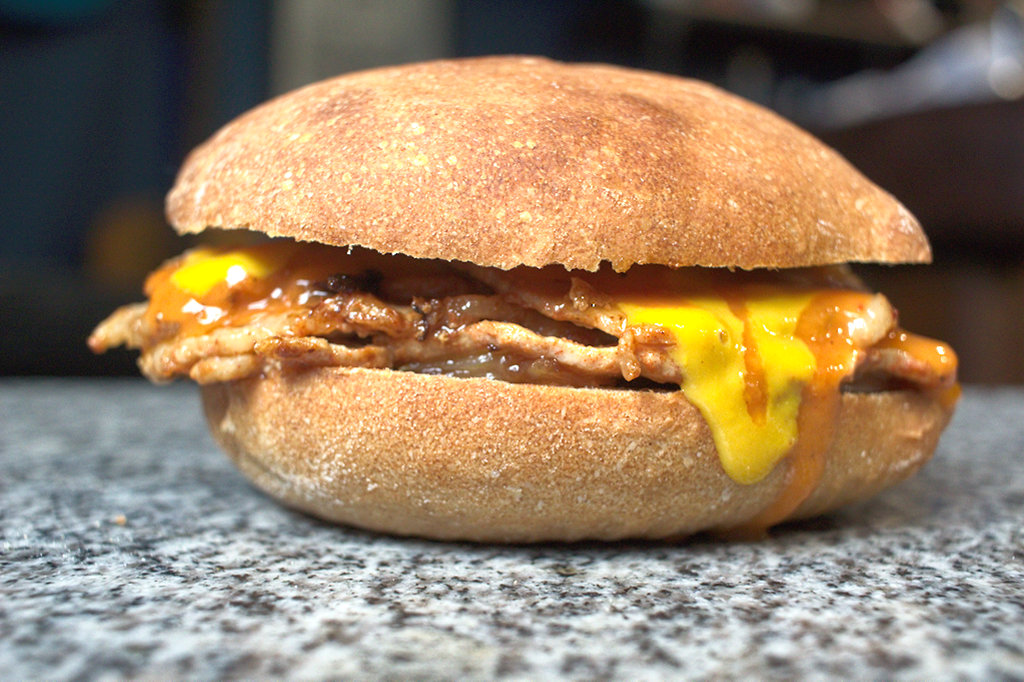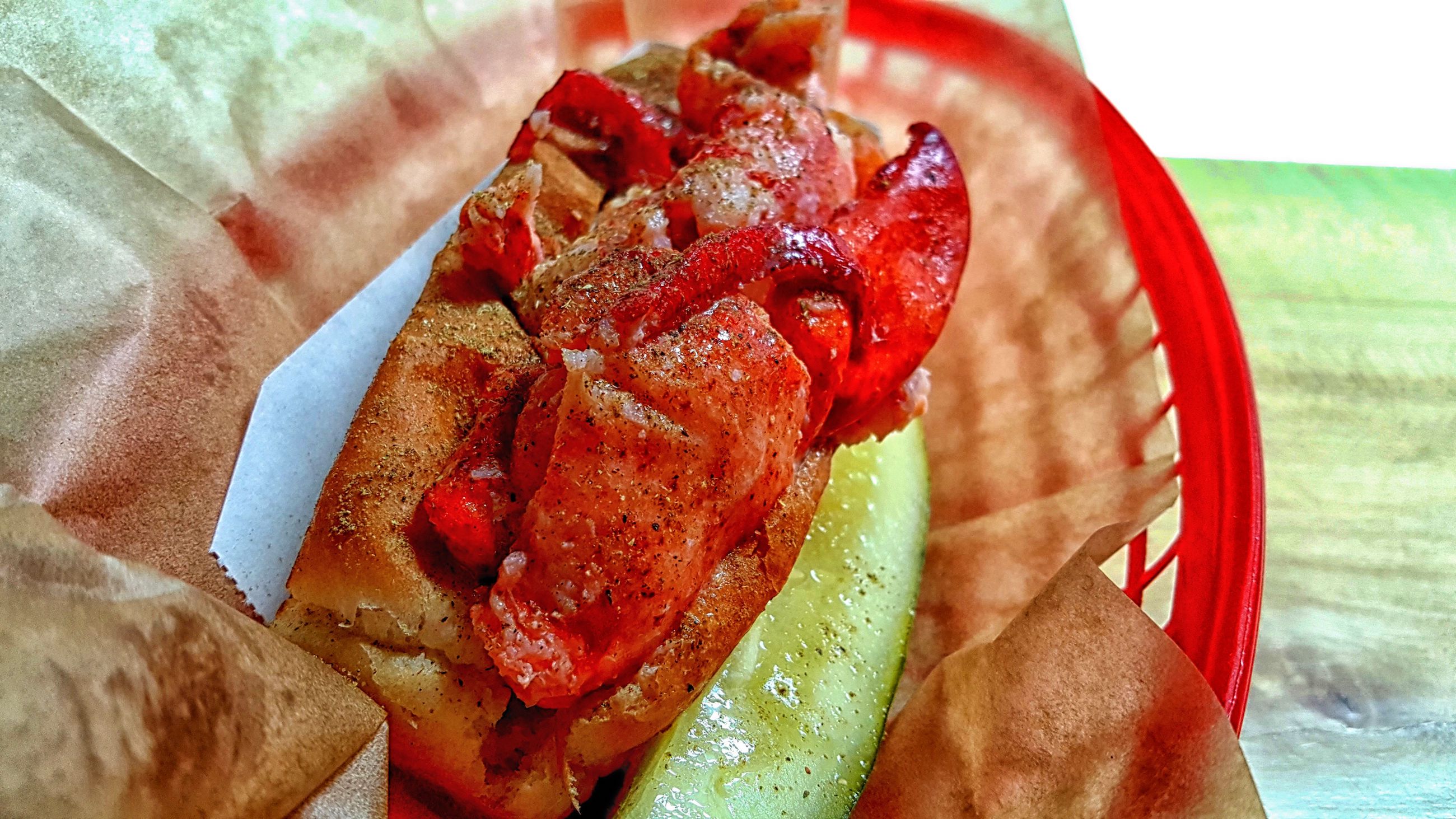Portuguese Bifana
A couple years ago, we wrote about a Portuguese steak sandwich called the Prego. It was a fantastic sandwich, and I drank a fantastic amount of Portuguese wine while enjoying it. Named after the nails of garlic pounded into the thin steaks as they’re griddled, that sandwich is commonly served in Lisbon as a dessert after an evening of snacking on seafood and drinking.
The Bifana is a similar sandwich, but made with thin-sliced pork instead of beef. At least, that’s how they make it in some places. In others, it may be served as a saucy shredded pork sandwich. The main division between the two types appears to be that Southern Portugal, down by Lisbon where the Prego is served, leans toward the thin-sliced lean pork; and Northern Portugal, up by Porto where the Francesinha reigns supreme, prefers the saucier version.
While even among the two main styles of Bifana there are likely many minor variants, the essentials of the sandwich appear to remain the same: garlicky pork on a crusty papo seco roll, perhaps condimented with some sweet Portuguese mustard or peri-peri sauce. Sometimes there ain’t nothing to it but to do it. And I happened to have on hand another bottle of my favorite Portuguese wine.

Portuguese rolls, called papo seco, are fantastic for sandwiches. Crisp-crusted and soft-crumbed, they are folded and the ends twisted when shaped to give them a distinctive two-lobed football shape. My shaping skills have only improved slightly since the last time I tried making them.

I was quite happy with how they turned out. It was a journey getting there though. I started out using a recipe I found online but apparently didn’t read through carefully enough before getting started. The recipe used a brief preferment, which I liked, but then I realized, once I’d added about half the water the recipe called for, that something was wrong. 512 grams of flour + 600 ml of water = a 117% hydration ratio. The dough would be soup! I read through the recipe again and then noticed that it referenced being “adapted” from another recipe, which I was able to locate here. 5 cups (640 grams) of flour + 2 cups (473 ml) of water = a 74% hydration ratio. Still a sticky dough, but workable.

Portuguese Papo Seco
But the twisted, pointed ends that typify this type of bread did snap back into a rounder shape while proofing. A few of the rolls still had a remnant of that shape though

I’m using the Janie’s Mill Artisanal Blend flour to make these, which isn’t the lighter-colored flour I’m used to in bread flours. This flour is “lightly sifted,” resulting in something darker than a white flour but not quite a whole grain flour. Finding ye olde King Arthur brand bread flour on shelves has been difficult lately, but I’ve appreciated the opportunity to try something new.

Of the recipes I’ve found online for the bifana, the Lisbon thin-sliced marinated pork appears to be the only version represented, and the commonalities include a marinade containing garlic, bay leaf, and white wine. Some may also include lemon juice, vinegar, paprika, or peri-peri sauce.

So I sliced some pork loin thinly, about 3.5mm thick, on my deli slicer, and marinated it overnight in 2 cups of pinot grigio, a whole head of garlic, peeled and chopped, 3 bay leaves, 2 tablespoons of mild peri-peri sauce, the juice of 1 lemon, a splash of white vinegar, a teaspoon of sweet Spanish paprika, and a little salt and pepper. Then I fried the marinated pork cutlets in a shallow layer of melted lard for 2-3 minutes on each side. While cooking the pork, I also sauteed some yellow onion in olive oil until soft and slightly brown.

First I added the onion

Then the pork

For additional condiments, I offered my family either the mild or hot peri-peri sauce and a yellow mustard. I have read that Portuguese yellow mustard is, or can be, a sweet mustard, so I doctored some Plochman’s with a little honey and dijon.

And that’s it! That’s the sandwich.

The crusty, hearty roll held its shape but cradled the ingredients well. The pork was richly porky from cooking in lard, but the wine and garlic of its marinade shone through, along with a hint of smokiness from the paprika. This peri-peri sauce is one of my favorite hot sauces, thick and hot and savory, with tomato and onion, vinegar and lemon juice, complementing the flavors of the pork. I crave excuses to buy it, so this sandwich was a boon to me on that score. Finally, the slight sweetness lent the sandwich by both the onions and the sweetened mustard rounded out the flavor–sweet and savory, rich and pungent and hot. The cross-section doesn’t do it justice.

It’s everything I could want in a sandwich, except that it’s kind of a pain to make, and Portugal is a long way to go for one. I understand that McDonald’s has tried introducing a McBifana in Portugal, but it doesn’t appear to be available on the International menu at McDonald’s Global HQ in Chicago or I’d have tried it as well.
But I figured I’d at least try to give the saucy Northern version a shot. I used reserved marinade to deglaze the pan I’d fried the pork in, reduced it, and then filtered it through a sieve to make a kind of pan sauce. I used this to reheat some of the pork, and even drizzled quite a bit of it directly into the Portuguese bread roll.

To this I added some of the reheated pork, as well as–why not?–some of the sauteed onions.

And since I just liked the combination so much, I went ahead and put peri-peri sauce and sweet mustard in as well.

So my saucy northern version wasn’t that different from the southern version after all. The pan sauce did change the texture, making it a little sloppier, and amping up the wine flavor already in the pork. And reheating the pork in the jus softened the lean pork a bit as well, though not to the point where it was shreddable. In a lot of ways, it was the same sandwich, just… more so.

Once again, the cross-section photo doesn’t convey the depth of flavor in this sandwich very well, but it does give an idea of the depth of penetration the pan sauce got into the bread. As soft as this crumb is, it’s still a sturdy bread.

I don’t anticipate this sandwich will be making its way on to many of your Memorial Day weekend menus. I myself will be smoking some pork butt, hot links, and rib tips and probably listening to a lot of Drive-By Truckers. But it’s worth a shot, if you ever make it to Portugal, or are just wondering what to do with a surplus of thin-sliced pork loin, white wine, garlic, and sandwich rolls you happen to have lying around.

I like sandwiches.
I like a lot of other things too but sandwiches are pretty great






Recent Comments